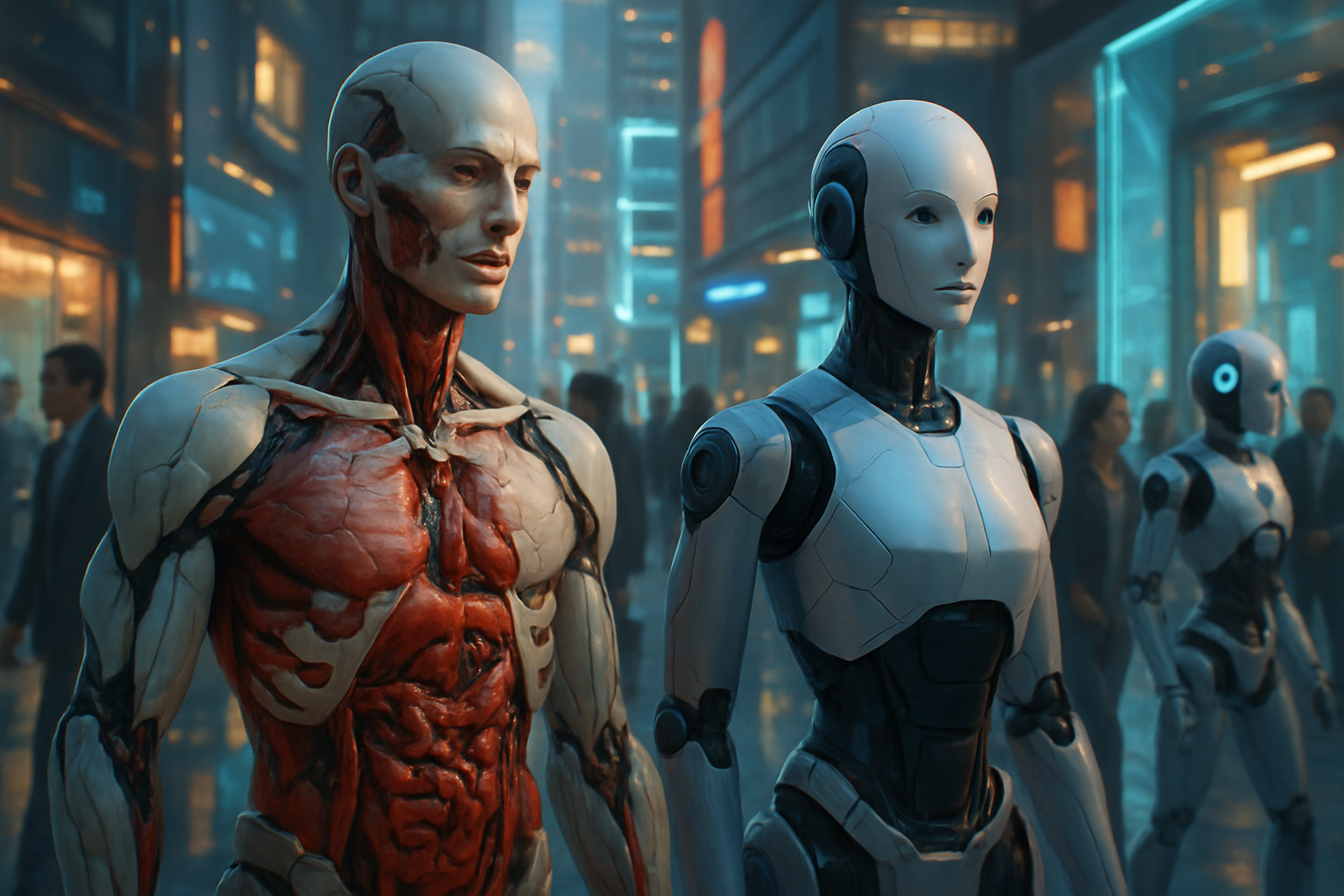The Uncanny Rise of Synthetic Humans: How Bleeding Androids and AI-Powered Organs Will Reshape the Next Decade
Discover the unsettling rise of androids in our world, as they blur the lines between human and machine with synthetic muscles and AI-driven minds. Are you ready for a future where robots might just deserve human rights?

Welcome to the Valley of the Uncanny
Picture this: You’re sipping your morning coffee. Out of the corner of your eye, a figure glides by—fluid, poised, eerily human. But when it turns, you notice the face is blank, the arms ripple with synthetic muscle, and if you poke it with a fork, it might just bleed. No, you haven’t stumbled onto the set of a dystopian reboot. You’ve entered the brave (and occasionally squeamish) new world of synthetic humans.
Clone Robotics' Protoclone: Meet the Bleeding Edge
In early 2025, Clone Robotics unveiled the Protoclone: a faceless, anatomically accurate android with over 200 degrees of freedom, powered by synthetic myofibers that mimic the twitchy, sinewy movements of human muscles. This machine doesn’t just walk the walk—it can kick, dangle, and, in a move straight out of a horror flick, "bleed out" if punctured. (Yes, the internet had a collective existential crisis.)
“Protoclone boasts over 200 degrees of freedom, 1,000 Myofibers, and 200 sensors… with synthetic organ systems that can bleed out.”
— Clone Robotics, 2025
And Clone isn’t alone. Across the globe, research labs and startups are racing to build androids that don’t just look human—they feel human. Artificial muscles, soft tissue, and even AI-powered circulatory systems are now on the menu.
The Science Behind the Sinew: AI Meets Synthetic Biology
The secret sauce? A blend of advanced robotics, synthetic biology, and machine learning. Protoclone’s myofibers—custom-made actuators—contract and relax like real muscle, powered by fluid dynamics and microcontrollers that let the android perform lifelike movements. Sensors track tension, position, and even (gulp) simulated pain.
Meanwhile, AI systems orchestrate these movements, adapting to new tasks in real time. Some prototypes are even exploring organ-level integration: think synthetic hearts, lungs, and kidneys, all monitored and optimized by neural networks. The ultimate goal? Androids that can heal, adapt, or even feel—at least in a digital sense.
From Home Helpers to Healthcare Heroes
While it’s tempting to imagine these creations as glorified Roombas with attitude, their real-world impact could be profound. Here’s what the next decade might hold:
- Home Robotics: Lifelike androids as personal assistants, elderly care companions, or even childcare helpers—capable of nuanced, empathetic interaction.
- Healthcare: Surgical androids with steady hands and rapid learning curves, rehabilitation bots that can physically support patients, or even synthetic organ donors for transplant trials.
- Manufacturing & Labor: Androids filling dangerous or repetitive jobs, able to work 24/7 without fatigue, and adapt to new roles as easily as updating their software.
- Entertainment & Companionship: Performers, actors, or partners that blur the line between real and artificial—raising both eyebrows and philosophical questions.
The Uncanny Valley Gets Crowded: Ethics, Law, and Existential Angst
But let’s not sweep the goosebumps under the rug. As these androids become more humanlike, society faces a cascade of thorny questions:
- Ethical Boundaries: Should robots that exhibit pain responses or emotions be afforded rights? What about privacy for humans living alongside AI-powered housemates?
- Legal Labyrinths: Who’s liable if a synthetic human malfunctions—or worse, develops emergent behaviors? How do we regulate their use in the workforce?
- Economic Upheaval: Will android labor accelerate job displacement, or create new markets and opportunities? How do we retrain a workforce when machines can out-learn us?
- Identity Crisis: As the line blurs, what does it mean to be "human"? Will synthetic beings challenge our notions of consciousness, empathy, or even love?
“If a robot can bleed, cry, and comfort you after a bad day—does it deserve a seat at the family table, or a place in the recycling bin?”
Looking Ahead: The Next Decade of Human-Machine Integration
Here’s the paradox: The more we succeed at building androids in our own image, the more we’re forced to reflect on our own humanity. The next decade will not just be about smarter machines, but about redefining relationships, responsibilities, and rights in a world where the synthetic and the biological are increasingly intertwined.
Will we embrace our new android neighbors—or recoil from their uncanny familiarity? The answer may come down to how thoughtfully we design, regulate, and relate to these next-gen beings. After all, the future isn’t just built in the lab; it’s shaped in the living room, the courtroom, and the collective imagination.
Let’s Keep the Conversation Human
If this article sparked your curiosity, discomfort, or a burning desire to debate whether you’d trust a bleeding android with your morning toast, join the Funaix community!
Subscribe for free today at https://www.funaix.com/become-a-funaix-insider-subscribe-for-smart-news-perks/ and become a Funaix Insider—where only subscribers can write and read blog comments, explore smart news, and help shape the future of tech coverage.
Subscribing is free (for now), and your voice matters more than ever in this strange, electrifying new era.
Published on August 11, 2025 — The future is closer (and weirder) than you think.




